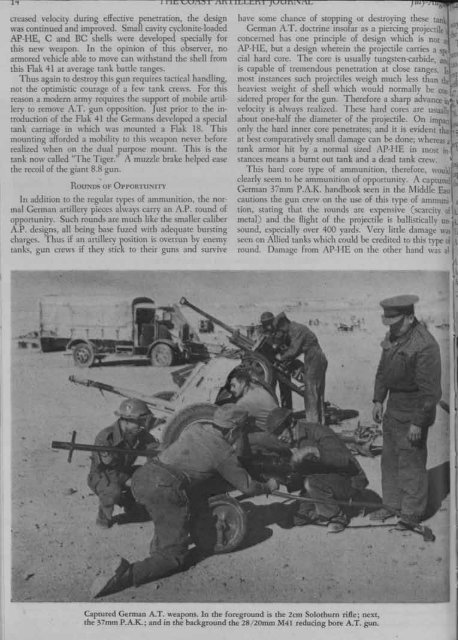July-August - Air Defense Artillery School
July-August - Air Defense Artillery School
July-August - Air Defense Artillery School
Create successful ePaper yourself
Turn your PDF publications into a flip-book with our unique Google optimized e-Paper software.
creased velocity during effective penetration, the design<br />
was continued and improved. Small cavity cyclonite-Ioaded<br />
AP-HE, C and BC shells were developed specially for<br />
this new weapon. In the opinion of this observer, no<br />
armored vehicle able to move can withstand the shell from<br />
this Flak 41 at average tank battle ranges.<br />
Thus again to destroy this gun requires tactical handling,<br />
not the optimistic courage of a few tank crews. For this<br />
reason a modern army requires the support of mobile artillery<br />
to remove A.T. gun opposition. Just prior to the introduction<br />
of the Flak 41 the Germans developed a special<br />
tank carriage in which was mounted a Flak 18. This<br />
mounting afforded a mobility to this weapon never before<br />
realized when on the dual purpose mount. This is the<br />
tank now called 'The Tiger." A muzzle brake helped ease<br />
the recoil of the giant 8.8 gun.<br />
ROUNDS OF OPPORTUNITY<br />
In addition to the regular types of ammunition, the normal<br />
German artillery pieces always carry an A.P. round of<br />
opportunity. Such rounds are much like the smaller caliber<br />
A.P. designs, all being base fuzed with adequate bursting<br />
charges. Thus if an artillery position is overrun by enemy<br />
tanks, gun crews if they stick to their guns and survive<br />
have some chance of stopping or destroying these ta<br />
German A.T. doctrine insofar as a piercing projectile<br />
concerned has one principle of design which is not<br />
AP-HE, but a design wherein the projectile carries a sptcial<br />
hard core. The core is usually tungsten-carbide, a I<br />
is capable of tremendous penetration at close ranges. I<br />
most instances such projectiles weigh much less than tilt<br />
heaviest weight of shell which would normally be COn _'<br />
sidered proper for the gun. Therefore a sharp advance in<br />
velocity is always realized. These hard cores are usualh<br />
about one-half the diameter of the projectile. On impact<br />
only the hard inner core penetrates; and it is evident tha<br />
at best comparatively small damage can be done; whereas<br />
tank armor hit by a normal sized AP-HE in most in<br />
stances means a burnt out tank and a dead tank crew. "<br />
This hard core type of ammunition, therefore, \\'OUld<br />
clearly seem to be ammunition of opportunity. A captured I<br />
German 37mm P.A.K. handbook seen in the l\'Iiddle EaSt<br />
cautions the gun crew on the use of this type of ammum (<br />
tion, stating that the rounds are expensive (scarcitv of \.'<br />
metal) and the Right of the projectile is ballistically' un '\.<br />
sound, especially over 400 yards. Very little damage wa<<br />
seen on Allied tanks which could be credited to this type of<br />
round. Damage from AP-HE on the other hand was al<br />
Captured German A.T. weapons. In the foreground is the 2cm Solothurn rifle; next,<br />
the 37mm P.A.K.; and in the background the 28j20mm M41 reducing bore A.T. gun.<br />
f -
















